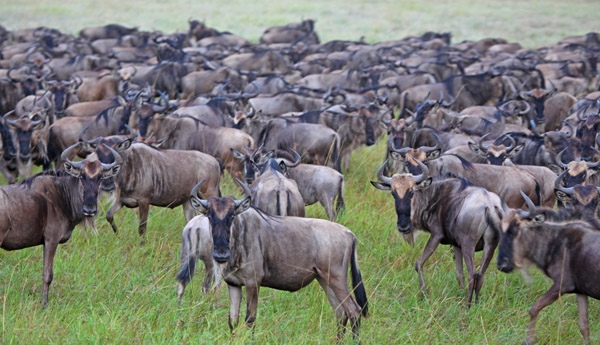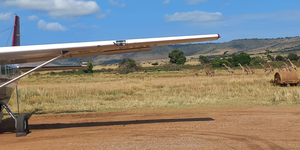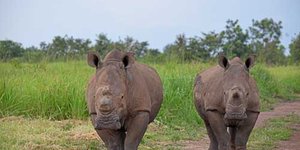Like this article?
Go on, give it a kudu!

Published on April 30 2014
Written by:
yourafricansafari.com
2287 views
The annual migration features over: 1.5 million wildebeest 400,000 zebra 200,000 gazelles
The migration moves through Serengeti National Park and the Masai Mara National Reserve
The great annual wildebeest migration is a spectacle many of us, even those who’ve not been on safari before, are familiar with. Courtesy of some excellent nature documentaries, we’ve been able to get up close and personal to the wildebeests as they desperately try to cross the crocodile-laden Mara River. We’ve seen them traverse a river by the hundreds, and gasped as the unlucky ones are nabbed by the swift blow of a crocodile jaw. If it’s this scintillating via television or internet, imagine how it must be in person!
Before jumping to the best times to see the great migration, let’s give a bit more detail on the great migration and where one can see it. Every year, around 1.5 to 2 million wildebeest, or gnu, migrate in a clockwise fashion in search of lush, green grasses as they follow the rain patterns. They start the year in Serengeti National Park, located in Tanzania, and move in a clockwise fashion up into the Masai Mara, which is found in Kenya, and then head south back into Tanzania.
Tanzania and Kenya are the two countries where one can witness this incredible event.
The wildebeest may be the stars of the migration, but they are not the only participants. They are joined by other ungulates such as zebra, gazelles, eland and impala. The old adage ‘there’s safety in numbers’ certainly holds true here. By traveling with other animals, the group is able to use the various strengths each animal possesses to help ensure they survive. Zebra have excellent eyesight but rely on the keen sense of hearing and smell, which their companions the wildebeest possess, to help get them from point A to point B safely.
‘When is the best time to see the great migration?’ This is the question I get asked most often, since the majority of people plan their safari around work or school schedules, and are left with only few months as viable contenders. Although there is no bad time to see the migration, some months may be more attractive depending on what one wishes to see. The migration also varies from year to year, and no two years are ever the same, making planning a bit tricky. Safari companies do their very best to put together an itinerary that puts you right in the middle of the migratory action, but it’s always advisable to spend several days in either the Serengeti or Masai Mara, to give your guide adequate time to locate the herd, should they not be exactly where your itinerary said they’d be.

December through March sees the migration primarily in the eastern and southern areas of the Serengeti, as well as in parts of the Ngorongoro Conservation area.
January marks the start of calving season for the wildebeest, which continues through March. The start of the year is a particularly popular time for those who are keen to see the tiny faces dotted throughout the plains.
February is the start of the long rain season, which is more pronounced in eastern Tanzania. Those planning on visiting Lake Manyara and Tarangire during the Serengeti safari may wish to allow for a few extra days.
April is the peak of the long rain season and with the rains come beautiful flowers and lush green grass. It’s also low season for most hotels. Those seeking reduced prices and crowds may wish to consider visiting the Serengeti in April. Somewhere towards the end of April to mid-May, the migration beings its journey west into central Serengeti. Central Serengeti has a wide array of lodging options and is also one of the areas where one can enjoy a hot air balloon rides.
Rut season begins sometime in March, and if you’ve never heard a wildebeest in rut, you are in for a surprise. You only have to stop and listen and your ears will be met with a cacophony of noisy grunts that permeate the air.
By June, the migration is fully in the western corridor of the Serengeti. The Grumeti River runs through this part of the Serengeti and those who visit during this time of year will likely get to see them cross this famous river. Sometime in July, depending on how much moisture there’s been during the year, the migration starts heading north, towards Kenya. They first must pass over the Mara River, which is a haven for photographers looking for that perfect river-crossing photo.
The lodging options in northern Serengeti tend to be higher-end, and the northern part of the Serengeti is the other area where hot air balloon rides are offered. July is the start of the dry season, and days usually bright and dry and nights can be chilly. Most northern hemisphere schools are now on summer break, so lodges tend to book up quickly.
By August, the migration is in the northern part of the Serengeti, or has crossed into the Masai Mara. These months are the peak safari months for those wishing to visit the Masai Mara. They are also peak season for hotels, which often book months in advance.
In November, the herd has normally returned back to the Serengeti or is well on its way. Depending on the year’s weather, the migration can be found in northern or central Serengeti. Come December, the herd moves back to central and eastern Serengeti and begins the cycle all over again.
The great migration is often a once-in-a-lifetime event. Some may spend several years saving up for the safari of their dreams. It’s important to remember that nature is not predictable and that the migration doesn’t always move in a forward motion. Sometimes it moves in a lateral direction and sometimes in a retrograde one. No one can precisely pinpoint the location of the migration and the best way to ensure you’re able to witness this event is to allocate enough time. By giving yourself and extra day or two, you give your guide the ability to talk to other guides and to help get you there with enough time to experience the spectacle over the course of a few days.
One thing is for sure, no matter what time of year you decide to visit either of these majestic places, you will be spoiled for choice when it comes to wildlife viewing opportunities.
Are you an expert on the great migration? Would you like to add more info to this article, or contribute to another migration-related article? Please contact us at safaris@yourafricansafari.com.
Has been on: 15 safaris
Your African Safari (YAS) is a safari-planning resource for anyone planning an African safari. It features information on over 2600 tour operators including company and vehicle descriptions, user reviews, safari itineraries and photos. It also features detailed information on 14 countries and 84 parks and game reserves.
© Your African Safari Ltd, All rights reserved.
Your African Safari is a safari-planning and safari review site. It was created to help support a healthy African wildlife population. All reviews are vetted before being approved and only ethical tours are published

Using charter flights on your next safari
Published on December 22 2025
By: yourafricansafari.com

Garamba National Park—an anchor of hope in the Democratic Republic of Congo
Published on January 09 2025
By: R.W.

Namibia imposes new visa requirements
Published on July 25 2024
By: yourafricansafari.com